
Sun – February 26, 2010
Sketch and Details by Stephen Ames
I use:
Crayola Cerulean pencil for plage
Crayola Aqua Green pencil for proms
White 20# paper
I scan into photoshop and invert.
Blue skies,
Stephen Ames
www.SeeMySunspot.com

Sun – February 26, 2010
Sketch and Details by Stephen Ames
I use:
Crayola Cerulean pencil for plage
Crayola Aqua Green pencil for proms
White 20# paper
I scan into photoshop and invert.
Blue skies,
Stephen Ames
www.SeeMySunspot.com

Solar Prominences
Sketch and Details by Jeff Young
As the sun is finally attaining some altitude above the trees on my horizon, I decided it was time to wake my Solarscope up from its winter hibernation. There was quite a bit of surface activity on view, but I had neglected to bring out my sketching materials for disk work. No matter, there was a nice prominence complex as well, and I had everything I needed for it.
White Derwent Graphitint pencil on black Strathmore Artagain paper.
Sketched from County Louth, Ireland.
As viewed through 70mm Solarscope h-alpha filter, Tele Vue Pronto, Astro-Physics Barlow, Baader MkV binoviewer and 19mm Panoptics.
Cheers,
— Jeff.
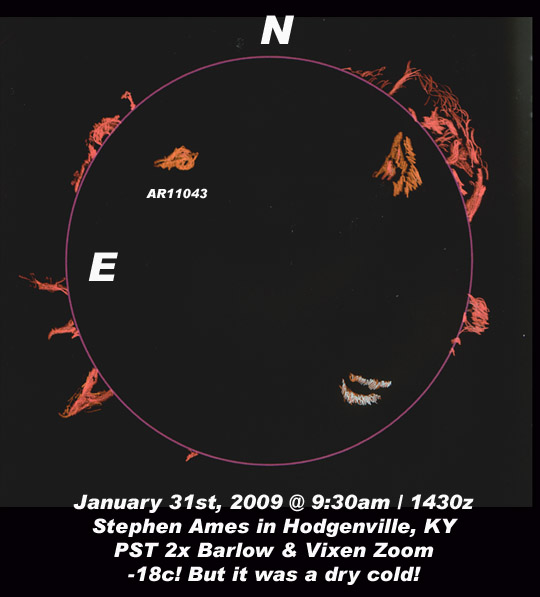
Sun – January 31, 2010
Sketch and Details by Stephen Ames
I use:
Crayola Cerulean pencil for plage
Crayola Aqua Green pencil for proms
White 20# paper
I scan into photoshop and invert.
Blue skies,
Stephen Ames
Hodgenville, KY
See your life giving sun in vivid images and art
from observers all over the world at
www.SeeMySunspot.com
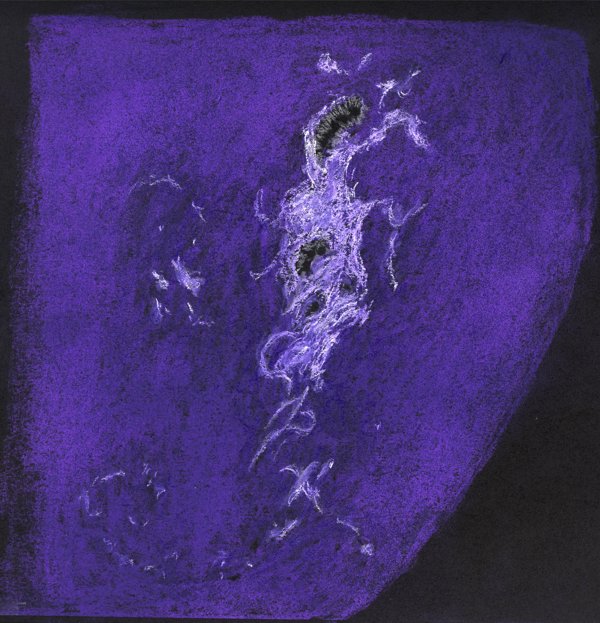
CaK AR11040 – January 14, 2010
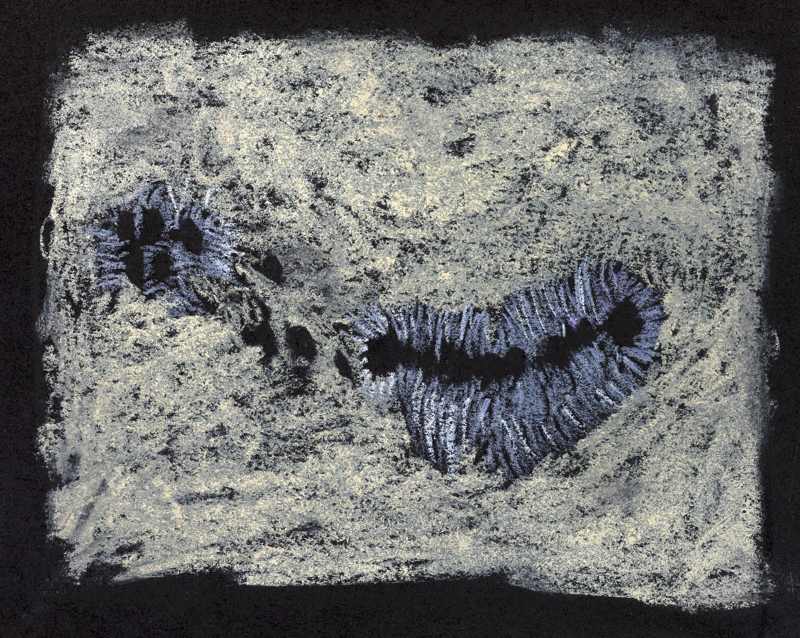
White Light AR11040 – January 14, 2010
Sketches and Details by Stephen W. Ramsden
Object Name AR11040
Object Type Solar Active Region and related Sunspots
Location Atlanta, GA –Jon Wood Observatory
Date 14 Jan 2010
The purple image is my interpretation of the Calcium K Line emissions from AR11040
The tan image is my sketch of the remaining Sunspot Group 1040 seen in white light
Conte chalks, pastels/Artagain paper, LUNT Solar Systems B1800 Cak Filter module on an Explore Scientific 127mm ED refractor.
I would strongly encourage all the solar photographers out there to give sketching a try. It gives you unique insights that cannot be caught on film. Thanks Stephen Ames and Erika for inspiration.
Stephen W. Ramsden
www.charliebates.org
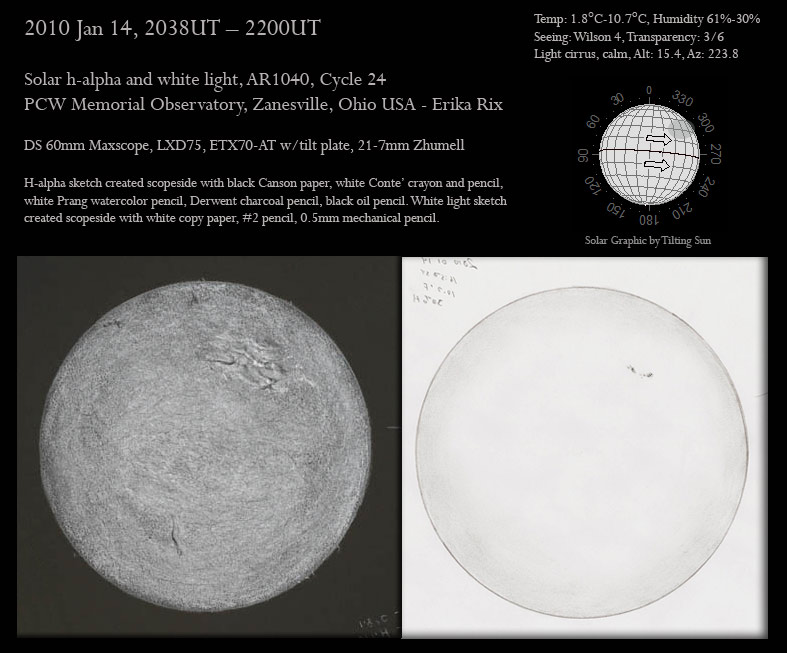
Sun – January 14, 2010, 2038 – 2200 UT
Sketch and Details by Erika Rix
2010 Jan 14, 2038UT – 2200UT
Solar h-alpha and white light, AR1040, Cycle 24
PCW Memorial Observatory, Zanesville, Ohio USA – Erika Rix
DS 60mm Maxscope, LXD75, ETX70-AT w/tilt plate, 21-7mm Zhumell
H-alpha sketch created scopeside with black Canson paper, white Conte’ crayon and pencil, white Prang watercolor pencil, Derwent charcoal pencil, black oil pencil. White light sketch created scopeside with white copy paper, #2 pencil, 0.5mm mechanical pencil.
Sketches were rotated and flipped to match standard solar orientation. West is to the right and north is to the top.
Temp: 1.8°C-10.7°C, Humidity 61%-30%
Seeing: Wilson 4, Transparency: 3/6
Light cirrus, calm, Alt: 15.4, Az: 223.8

H-Alpha Sun – December 29, 2009
Sketch and Details by Stephen Ames
Crayola Cerulean for plage
Conti White pencil for filament
Crayola Aqua Green pencil for proms
white 20# paper with Aqua Green disk
I scan into photoshop and invert.
Blue skies,
Stephen Ames
Hodgenville, KY
http://www.seemysunspot.com/
Sun (AR1035)
Sketch and details by Michael Rosolina
Here are a pair of white light observations I made of a new Solar Cycle 24 active region which suddenly appeared on the solar disk on December 14th. One can see that these areas of solar activity are changing constantly as they rotate with the Sun. The sunspot group spans a distance from east to west of about nine Earth diameters or 72,000 miles/116,000 km.
The sketches were done in the field with 2B and HB graphite pencils. I viewed the Sun through handheld image stabilized binoculars with homemade filters over the objectives. Remember: NEVER look at the Sun unless you have approved solar filters covering the objective end of your telescope or binoculars or you are using a solar telescope designed for that purpose.
The Sun and AR 1035
Star and active region
White Sulphur Springs, WV USA
16 and 17 December 2009
Michael Rosolina
Jupiter moon Europa has just transited Ganymede, November 17, 2009
Sketch and Details by Michael Rosolina
Because of the geometry of Earth’s orbit in relation to Jupiter’s orbit, this has been a very good year for seeing transits across the Jovian disk. Not only have there been numerous transits of the Galilean moons and their shadows, the moons themselves have been transiting and occulting one another as seen from our vantage point here on Earth.
In this sketch, Europa has just completed an annular transit of Ganymede, passing in front of the larger moon but not blocking it completely. Because of Jupiter’s low altitude, I was unable to use high enough magnification to see any detail of the transit beyond watching the two bright dots move towards each other, merge, and then move apart.
At the same time, Callisto (the largest Galilean moon) was transiting in front of Jupiter. Unlike the two smaller moons, Io and Europa, which tend to disappear from view after they cross the Jovian limb, Callisto (and Ganymede) usually can be seen against the cloudtops due to their darker albedo. [All of the moons’ shadows can be seen in transit given adequate seeing conditions.]
This sketch of Jupiter was done at the eyepiece using 2B and 4B graphite pencils on white copy paper. After scanning, I set Jupiter against a black digital background, placed the positions of the satellites from field notes, and added the text.
I hope you enjoy this view of the King and his consorts and get a chance to see one of these transits yourself before the giant planet disappears for the year.
Jupiter and Galilean Moons
Planet
Friars Hill, WV USA
17 November 2009
Clear skies,
Michael Rosolina
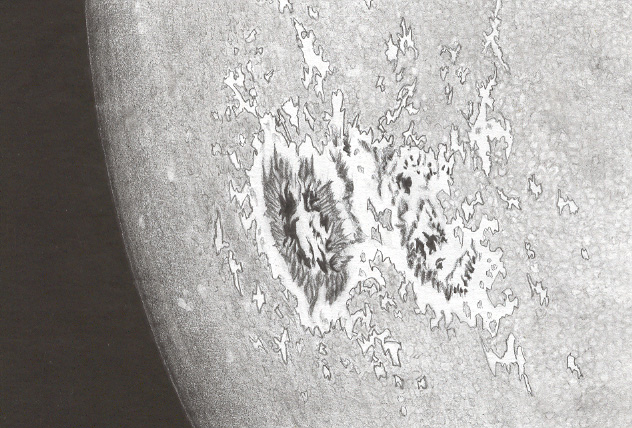
Active Region 1027 on October 29th, 2009
Sketch and Details by Fred Burgeot
* object : solar spot 1027.
* location : Vendée, France.
* date : 29/10/2009 at 14H15 TU.
Sketch made with graphite pencils (2H to 4B) on white paper. The telescope used is a 16″ Newtonian, equiped with Baader Astrosolar filter, magnification 175X with binoviewer.
It was made during afternoon, when the seeing conditions are currently better than in the morning.
Because of the proximity of the edge, a bright zone appears surrounding the spot group itself.
Best regards,
Fred Burgeot.